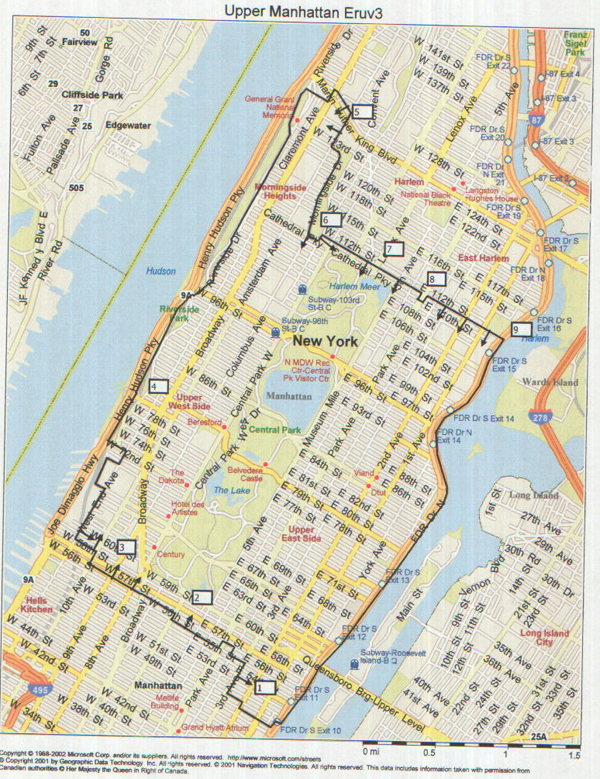

:: the manhattan eruv project ::
presentation The Steel Yard :: 5.29 5:00p
documentation CUBE2 :: 5.19- 6.4
website www.dziga.com
The Manhattan Eruv Project is an
exploration of urban religious
psychogeography in New York City. It investigates notions of public and
private space stemming from the Jewish observation of the Sabbath. My
presentation will cover the history and principles of eruv construction
in Manhattan, and will outline my ongoing artistic work pertaining to
this research.
What is an eruv?
An eruv is a religious
boundary that is erected around orthodox Jewish
communites throughout the world. An eruv usually consists of a series
of poles connected by galvanized steel wire that circumscribe the
Jewish community. They often incorporate existing municipal
infrastructure such as utility poles and electrical wires, so long as
they are used in accordance with the lengthy and complex set of kosher
architectural laws set forth in the Talmud, a sacred text written by a
series of Rabbinic sages around 500 CE.
The construction of eruvin
stems from the observation of the Sabbath,
the weekly sacred day of rest (Friday sundown to Saturday sundown) that
includes a prohibition against carrying objects outside of one's home,
or private domain. The actual Biblical declaration of this law occurs
in the Old Testament which states briefly but very specifically that
the transferral of objects between public and private domains is a form
of work and hence a violation of the Sabbath. The reason Jews construct
eruvin is that according to most Rabbinic authorities, the shared
public space within an eruv is considered the private domain of the
community. In this way, observant Jews can carry their keys or prayer
books on the Sabbath while acting in accordance with sacred principles.
According to Webster's New World Hebrew-English Dictionary, an eruv is
a "religious legal fiction drawing a symbolic fence around a town or
parts thereof so that the encompassed area may be regarded as one's own
yard."
Is Manhattan an eruv?
Natural topographic boundaries
such as rivers, cliffs and ravines can
also form one or more legitimate sides of an eruv. For this reason, it
is possible from a number of Talmudic perspectives to consider the
island of Manhattan a natural eruv. This has been debated over the
centuries-long course of Jewish habitation on the island. At one point,
before the dismantling of the old Third Avenue commuter train line in
1955, the elevated tracks formed the western side of an eruv used by
the immigrant Polish Chasidic community. Presently, the Fifth Avenue
Synaoguge on the Upper East Side maintains a pole and wire-based eruv
that encompasses all of Central Park. Some scholars agree that that
these are all legitimate eruvin while some argue that none of them are
kosher. What complicates matters is that the laws pertaining to eruvin
depend upon an intepretation of a text that was written for the needs
of a bygone era. (Some rabbis insist that the Talmud itself is too
liberal in its interpretation of the Torah, which is considered the
word of God - while the former is considered the authoritative human
interpretation of the word of God.)
about the artist
Elliott Malkin
is a 31 year-old artist, technologist, and teacher,
originally from Chicago but currently living in New York City. For the
past two years, Elliott has been living in the East Village while
teaching writing at New York University and completing a Master’s at
NYU’s Tisch School of the Arts, where he has been focusing on digital
video and electronics. His professional work has included a two-year
stint as a Senior Producer and Information Architect at the London
office of Razorfish, a new media design agency. Elliott also has a
Master's degree in Learning Science, a combination of computer science
and educational psychology, from Northwestern University in Chicago.
His electronic artworks, “128.122.158.151” and “Crucifix
NG,” which
draw their inspiration from Judeo-Christian mythology, have been
featured on Rhizome.org.
His videos, including “Shave,” “My Bris,” and
“Family Movie,” have been featured at festivals around New York
City,
including the New York Jewish Film Festival at Lincoln Center. He is
currently producing and directing an experimental video documentary
entitled “Mother’s History of Birds,” an exploration of
an artist’s
memory through the life and death of her pet birds.
